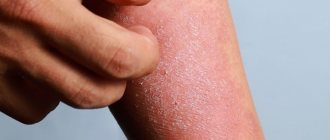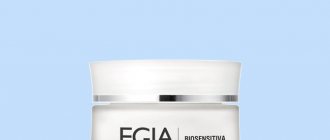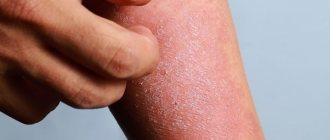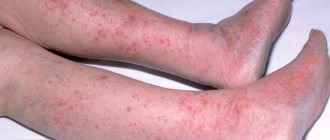There are many reasons why ears become flaky. In summer, this symptom can be the result of exposure to sunlight, in winter - cold. Sometimes the problem lies in improper hygiene procedures. For example, cotton swabs, which many people use to clean their ear canals, can injure or rub skin unprotected by wax.
Sometimes the ear itches due to allergies, and peeling is a manifestation of a serious illness, so in any situation the best solution would be to see a doctor.
- Treatment
- Treatment
- Folk remedies
Causes of ear dermatitis
There are several different conditions that can cause dermatitis of the auricle or ear canal. All these pathological processes have their own provoking factors and trigger conditions.
- Atopic eczema is quite often localized in the parotid area. If ear dermatitis appears in a child, as a rule, it is based on an atopic process. The disease is caused by hereditarily caused defects in the functioning of the immune system in combination with environmental factors. This leads to a breakdown of the protective barrier of the epidermis, making it vulnerable to infections and allergies.
- A contact reaction is an inflammation of the skin in response to direct contact with an irritating or allergenic substance.
- Seborrheic lesion is a condition associated with improper functioning of the sebaceous glands, which often causes ear dermatitis in infants.
- Otitis externa is a bacterial process when, with prolonged inflammation and poor hygiene, an infection occurs. This process can be both acute and chronic.
Main provoking factors:
- Soap, detergents, wet wipes,
- Food allergens such as soy, milk, nuts, seafood, wheat,
- Some metals: nickel, chromium,
- Perfumed care cosmetics, soaps, perfumes,
- Rough fabrics that come into contact with the body: wool, synthetics,
- Antiseptic products, disinfectants,
- Cigarette smoke
- Psycho-emotional stress,
- Dry air
- Hot climate,
- Infections.
Furuncle
Another reason why the earlobe peels may be the formation of a boil inside the dermis. It occurs when an infection enters the epidermis and indicates the onset of an inflammatory process. It occurs in the sebaceous glands, follicle or in the deep layers of the skin.
At the initial stage of inflammation, a person feels itching, redness and peeling. In cases of complications, the boil causes unbearable pain. Treatment with medications in this case is impossible; surgical intervention is required. After this - a long course of therapy with antibacterial agents.
Symptoms of ear dermatitis
Auricular eczema causes symptoms similar to eczema on any other part of the body. Patients may have:
- Dry, flaky skin around the external auditory canal, on the concha and in the parotid area,
- The same changes can affect the external canal of the auditory organ,
- Redness and swelling of the ear and parotid area,
- Itching around and inside the ear canal,
- Clear discharge from the ear.
Often these changes extend to the area behind the ear and affect the fold where the ear joins the head.
For most people, symptoms of eczema are mild or moderate. But in some cases the itching is very pronounced, and then the following symptoms also appear:
- The skin becomes bright red or dark,
- Severe swelling appears,
- There are areas of very dry and sensitive skin,
- The flaky areas take on a rough, leathery appearance,
- Inflamed skin becomes wet, bleeds and becomes covered with drying yellowish crusts,
- An infection of the external auditory canal occurs.
Infectious inflammations are a special group of ear diseases that require a careful approach to treatment, so these conditions must be treated under the supervision of a doctor. The infection can be primary, when microorganisms infect a healthy ear, or secondary, when it develops against the background of some kind of skin disease. Otitis externa often affects swimmers. Pool water entering the ear washes away protective wax and causes dryness.
Symptoms of infectious external otitis:
- Ear pain, which can be very intense,
- Itching of the ear canal,
- Discharge of fluid or pus from the ear,
- There may be some degree of mild hearing loss,
- The temperature may rise.
If these manifestations appear, you cannot self-medicate; you need a doctor to select medications.
Fungal infection
If the earlobe of an adult or child peels, it may be a fungus. Typically, infection occurs against the background of reduced immunity and the presence of favorable conditions for the life processes of pests. In particular, excessive hygiene can lead to disruption of the natural microflora when the ears are excessively treated with water and other means.
Symptoms of fungal infection include:
- headache;
- sensation of a foreign body in the ears;
- noise;
- itching and peeling;
- various types of discharge from the ear.
In most cases, the lesions are caused by candida or aspergillus fungi, less often the cause of the disease is Staphylococcus aureus. The treatment for such a problem is the same for all parts of the body.
First of all, the type of fungus is determined, only after that special ointments and creams are prescribed. Treatment inside the ear involves the use of a cotton swab onto which a medicinal composition is applied. If an allergic reaction to the drug occurs, it is replaced with another drug of similar action.
Ear dermatitis in an adult
Ear dermatitis is common in older people, and in adults it is usually contact eczema or bacterial inflammation. Contact eczema is caused by metal jewelry, glasses, headphones, earplugs, as well as hair dye, some care products, and perfume, which is sometimes applied to the earlobes. Bacteria can enter the outer ear canal through bathing, swimming in pools and especially in open water, and when the skin inside the ear is damaged, such as by scratching or cleaning the ears.
Diagnostics
When the first symptoms appear, you should contact an otolaryngologist. The doctor examines the affected area and reviews the patient's medical history. Based on the data obtained, a referral for testing is issued. If the peeling is very visible, a swab is taken from the ear to determine the presence of fungus.
To exclude other pathologies, a general blood test will be required. If this is not enough, additional diagnostics are performed. Before prescribing therapy, it is necessary to determine the cause of ear seborrhea. An experienced specialist examines all the information received and makes a final diagnosis.
Ear dermatitis in a child
Ear dermatitis in the form of seborrheic and atopic (as shown in the photo) are the most common causes of skin lesions in the ear area in children. Seborrhea affects the area behind the ears, the postauricular fold and the concha itself. Peeling appears and yellowish greasy crusts accumulate. The itching is not very pronounced. In this case, the scalp is also significantly affected. Sometimes parents notice a connection between pathology and errors in diet. Treatment consists of mechanical removal of the crusts after softening with almond oil. Children outgrow this problem; in adulthood, the ears are affected much less frequently.
Atopic eczema manifests itself as intense itching with peeling and weeping, and is often localized in the ear canal. Atopy is often common when eczema is located in a baby on the cheeks, neck, skin folds, and is combined with bronchial asthma and seasonal pollen allergies.
Therapy
Therapeutic measures are started only after identifying the cause of the disease; most often, treatment is carried out at home.
If the earlobe is peeling due to an allergic reaction to medications, insect bites, food, hair dye, jewelry, treat with antihistamines, external medications and soothing compresses. For example, “Loratadine”, “Finistil”, “Lorinden”. If an allergy causative agent is identified, it must be eliminated.
If the reason lies in poor hygiene, then solving the problem will not be difficult. You should regularly wash the affected skin with soap.
Irritation caused by neuroses and stress is treated by eliminating the root cause. It is necessary to take sedatives, herbal infusions and avoid stressful situations. For example, tincture of valerian, “Nevrohel”, “Persen”.
If the cause of flaking and itching of the ears is caused by a deficiency of vitamins and nutrients, then it is necessary to change the daily diet, consume more foods containing microelements and minerals to compensate for their deficiency. You can buy complexes, for example, “Complivit”, “Supradin”, “Vitrum”.
Diseases, the symptoms of which are manifested by peeling of the ears, are treated after consulting a doctor and making a diagnosis. It is not always dermatitis, as is commonly thought; in some cases, itching can be caused by diabetes. After determining the cause of the pathology, the doctor will prescribe treatment. For different types of dermatitis, it consists of taking tablets, using creams and ointments, and physical therapy.
Treatment of ear dermatitis
Depending on the underlying cause, treatment for inflammation of the skin around the ear may vary. However, in most cases it begins with general home measures and changes in routine. This approach includes:
- Rinse your ears with warm (but not hot) water every evening,
- Using a gentle, hypoallergenic moisturizer immediately after water treatments to “lock in” moisture and prevent skin dehydration,
- Eliminating all triggers that come into contact with the skin. Thus, the condition is often provoked by metal earrings, which contain nickel. They need to be replaced with hypoallergenic gold-plated or silver ones,
- Wearing a hat that covers the ears during the cold season, since cold can serve as a provoking factor for the development of the described pathology,
- Switching to the use of hypoallergenic skin care products that do not contain dyes, fragrances, ethyl alcohol and harsh surfactants,
In any case, before starting treatment of any skin lesion in the parotid area, you should consult your doctor. Only a specialist can correctly diagnose and select the right treatment, even if therapy can be carried out with home remedies.
Treatment of ear dermatitis with medications
In some cases, ear dermatitis does not respond to methods such as changing the regime and caring for the skin of the ears, in such cases it must be treated with pharmaceutical products.
Sometimes you have to choose the right remedy. If the first prescribed treatment does not show the expected effect, the doctor will prescribe an alternative method or a new combination of drugs.
Treatment may include various combinations of the following:
- Steroid hormones in the form of ointments are applied to the affected areas, which are itchy and weepy. Often ear dermatitis is located in the fold behind the ear, in this case glucocorticoid ointment is especially indicated, and patients leave good reviews about its effectiveness. Drugs from this group relieve inflammation, eliminate itching, swelling, peeling and other symptoms. If the skin lesion is located inside the canal, steroids are applied in the form of drops.
- Antihistamines are drugs in tablets whose main effect is antipruritic.
- Antifungal agents are effective in the seborrheic process, in the development of which, as scientists suggest, a microscopic fungus plays a role. Often these drugs are prescribed simultaneously with other groups of drugs.
- Antibiotics are indicated for bacterial dermatitis, or otitis externa.
- Non-hormonal ointments and drops have different directions of action. Compositions with moisturizing additives help retain moisture in the dermis and affect dryness and flaking. Salicylic emulsion exfoliates and eliminates dead epithelial cells. Herbal extracts and naftalan oil soothe and fight inflammation. Natural oils (coconut, shea, almond) effectively soften and “lock in” moisture. Olive oil, on the contrary, is not recommended, since studies have confirmed that it disrupts the barrier functions of the epithelium.
Precautionary measures
If you have just managed to get rid of the unfortunate crust in your ears, then you are still at risk. To prevent the disease from appearing again, follow the recommendations of experienced dermatologists:
- observe personal hygiene rules, do not use other people’s accessories (for example, headphones or earplugs) and wash your ears regularly;
- Otolaryngologists prohibit the use of cotton swabs to clean the ears, because they destroy epithelial cells and eliminate the protective lubricant formed in the ear canal;
- Spend more time outdoors and try to follow the generally accepted daily routine (it is advisable to sleep at least 8 hours);
- Under no circumstances should you overcool your ears during the cold season, so buy a hat;
- protect your ears from water, especially chlorinated water, getting into them (you should get a special swimming cap);
- if a person wears a hearing aid, it is necessary to regularly clean the device and use special ear drops;
- do not start treatment for otitis media and boils, otherwise it will be difficult to get rid of the crust in the auricle;
- drink still mineral water as much as possible , because it will help improve your metabolism;
- try to avoid stressful situations (you can improve your perception of the world around you by doing yoga or reading books on self-development and psychology);
- start eating a balanced diet (fruits, vegetables, herbs, cereals, meat and dairy products).
Important point! If dandruff in the ears is left untreated, acute mycosis may develop. The fungus acts not only locally, but also begins to penetrate deep into the tissues of the body.
To treat dandruff in the ears, you need to use an integrated approach - at the same time eliminate the cosmetic problem with the help of ointments, lotions and tablets, and also begin to lead a healthy lifestyle, eating foods rich in fiber and vitamins. Remember to drink at least 2.5 liters of water per day.
You should not think that the white grains will immediately begin to disappear; at least 2 months must pass for the skin on your ears to regain its previous healthy appearance.
Carrying out prevention
Since the formation of crusts in the ear is just a symptom, all preventive measures should be aimed at preventing the development of possible diseases. That is why prevention means:
- timely contact a doctor for help;
- increasing immunity;
- proper nutrition;
- eliminating stress;
- preventing hypothermia;
- proper ear hygiene;
- general hygiene.
Most people do not pay attention to the formation of crusts, believing that they are nothing serious. However, this is wrong, since they signal the onset of the disease. At the first signs, you should immediately consult a doctor.
Medicines
Treatment for dry ears depends on the type of problem. The type of medication is prescribed based on the type of fungus. Usually in this case, drugs such as Nitrofugin, Econazole, and Pimafucin are prescribed.
To treat otitis, you need antibacterial drugs - Levomekol, Triderm. And if allergies occur, Diazolin or other tablets with a calming effect are prescribed.
Folk remedies
Folk methods that help eliminate dry ear include:
- Baby cream. It is applied with soft, gentle movements to problem areas as needed.
- Motherwort tincture. She treats the skin behind the ears twice a day. To prepare, you will need a glass of alcohol, which is poured over the crushed rhizomes of the plant (10 g). Then mix everything, cover with a lid and leave in a warm place for 10 days. Then carefully filter.
- Chamomile based decoction. To prepare, dried flowers (2 tbsp) are mixed with boiling water (1 cup). The broth is stirred and cooled. Then use a sponge to treat problem areas of the skin and apply a compress.
- Onion juice is instilled into the ear - 5 drops per day, no more than 5 times in a row.
- Dry the salt in a dry frying pan, put it in gauze and apply it to the ear for a few minutes. The product relieves peeling and severe pain.
Before using any folk remedy, it is advisable to consult a specialist. This will prevent harm to the body.
Feature of the violation
Crusts in a person’s ears can appear for a variety of reasons, ranging from microtrauma to dangerous inflammatory processes. They often appear in infectious diseases, psoriasis, dermatitis, and many other problems.
In addition to diseases, mechanical damage can provoke such a disorder. These include microtraumas that can occur due to improper hygiene, as well as more serious injuries resulting from direct or indirect impact on the ears.
In any case, damage to the skin is observed, as a result of which blood plasma leaks through the cells, dries out, and crusts form. Their features largely depend on the ongoing pathology. It is very important to determine in a timely manner why crusts form in the ear, and also try to deal with the existing problem as quickly as possible.
Childhood
A crack behind the ear in a child is a fairly common problem, but it requires the direct involvement of a doctor. This is primarily due to the fact that in babies the dermis is still quite loose, the connective fibers are poorly developed, and the veins are intensely filled with blood. It is clear that these factors are not enough for the development of inflammatory processes; damage occurs against the background of general changes in the body or under the influence of local causes. Most often, cracks appear due to diaper rash or fungal infection. But the cause of the appearance may be dermatitis, diathesis or eczema.
Parents should monitor the diet and gradually introduce new foods into it. The temperature regime is very important, that is, the room where the child sleeps should be warm, but not hot, and the air should not be dry. It is also recommended to carefully select washing powders so that they do not cause irritation to the skin.
Psoriasis
This is an inflammatory dermatological pathology that does not select age and gender. Psoriasis often appears in the knees, elbows and head. The exact cause of this problem is still unknown. It is characterized by a very thick and red rash that becomes covered with scales and crusts. If the rash appears on the head, it often spreads to the ear area. All therapeutic measures in this case are aimed at stopping the further development of the skin rash. Most often, cortisone-containing ointments are used for treatment; herbal remedies may be prescribed and injection therapy may be performed.
Ointments and creams
The doctor may prescribe a pharmaceutical cream intended for the treatment of ear ailments. The following funds are in demand:
- "Triderm".
- "Sinaflan".
- Akriderm.
- Conizon Plus.
Detailed instructions are included with each medication. Before using the drug, you should familiarize yourself with the dosage and duration of treatment.











